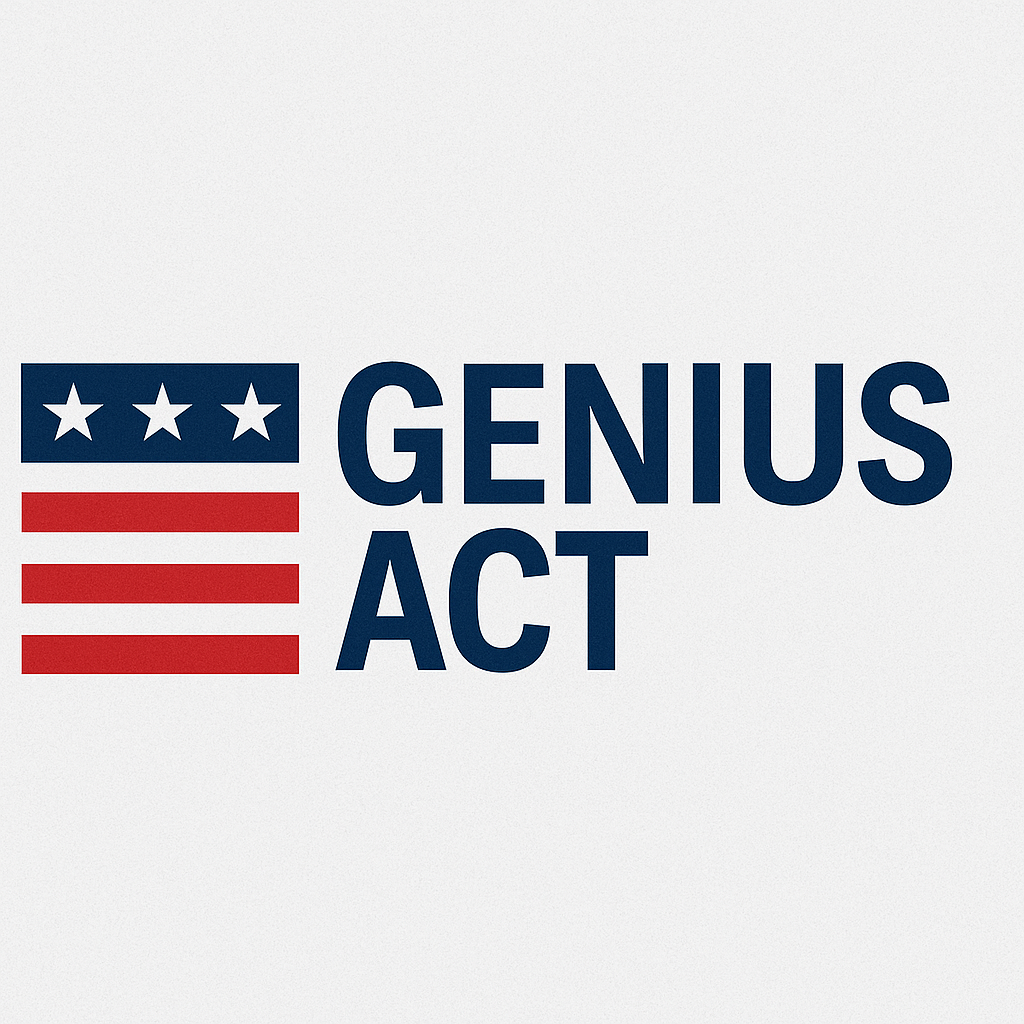What Is the GENIUS Act?
The GENIUS Act, officially known as the Guiding and Establishing National Innovation for U.S. Stablecoins Act, represents a watershed moment in American financial regulation. Signed into law by President Donald Trump on Friday, July 18, 2025, this groundbreaking legislation establishes the first comprehensive federal regulatory framework for stablecoins in the United States.
The bill passed with strong bipartisan support, with the Senate voting 68-30 and the House voting 308-122, demonstrating rare cross-party consensus on digital asset regulation. This historic legislation aims to regulate the roughly $238 billion stablecoin market, creating clear guidelines for banks, companies, and other entities to issue digital currencies.
Understanding Stablecoins: The Foundation of Digital Finance
Before diving into the Act's implications, it's crucial to understand what stablecoins are and why they matter. A stablecoin is a type of cryptocurrency that is pegged to another asset, typically the U.S. dollar, which makes it less volatile than other cryptocurrencies like Bitcoin. Unlike traditional cryptocurrencies that can experience dramatic price swings, stablecoins maintain relatively stable values, making them suitable for:
- Digital payments and transactions
- Cross-border money transfers
- Trading and futures markets
- Corporate treasury management
- Decentralized finance (DeFi) applications
Key Provisions of the GENIUS Act
Reserve Requirements and Asset Backing
The GENIUS Act requires 100% reserve backing with liquid assets like U.S. Treasuries and cash equivalents. This provision ensures that every stablecoin issued has corresponding real-world assets backing its value, providing crucial consumer protection and maintaining the peg to the underlying asset.
Key reserve requirements include:
- Segregation of reserves from issuer's operational funds
- Monthly third-party audits and certifications
- Minimum liquid capital standards for issuers
- Priority claims for stablecoin holders in bankruptcy proceedings
Regulatory Framework and Oversight
The legislation establishes clear regulatory roles across multiple federal agencies:
- Office of the Comptroller of the Currency (OCC): Primary regulator for standalone stablecoin issuers
- Federal Reserve: Oversight of systemically important stablecoin arrangements
- Federal Deposit Insurance Corporation (FDIC): Regulation of FDIC-supervised institutions issuing stablecoins
- National Credit Union Administration: Oversight of credit union stablecoin activities
Licensing and Compliance Standards
Under the GENIUS Act, stablecoin issuers must obtain proper licensing and meet stringent compliance requirements:
- Anti-money laundering (AML) protocols
- Know Your Customer (KYC) procedures
- Sanctions compliance and reporting
- Consumer protection measures
- Operational risk management standards
Market Impact and Industry Transformation
Breaking the Duopoly
Currently, the stablecoin market is dominated by two major players: Circle's USDC and Tether's USDT. The GENIUS Act creates a clear pathway for traditional financial institutions to enter the market, potentially ending this duopoly and fostering healthy competition.
Industry analysts predict we'll see a flood of new issuers rush into the market, including:
- Major commercial banks
- Payment processors
- Fintech companies
- Technology corporations
Institutional Adoption Acceleration
The regulatory clarity provided by the GENIUS Act removes significant barriers to institutional adoption. Large banks and financial institutions, previously hesitant to enter the stablecoin space due to regulatory uncertainty, now have a clear framework for participation.
Several major U.S. banks and payment platforms are reportedly already in discussions about issuing joint stablecoins, signaling the beginning of mainstream institutional engagement with digital currencies.
Economic and Strategic Implications
Strengthening Dollar Dominance
One of the Act's most significant strategic benefits is its potential to strengthen the U.S. dollar's position as the global reserve currency. Since 99% of stablecoins are pegged to the USD, increased stablecoin adoption worldwide effectively expands dollar usage and demand.
The legislation will generate increased demand for U.S. Treasury securities, as stablecoin issuers must back their assets with these instruments. This creates a virtuous cycle supporting both the dollar's global dominance and the U.S. government bond market.
Innovation and Competition Benefits
The GENIUS Act is expected to drive innovation in several areas:
- Payment efficiency: Faster, cheaper cross-border transactions
- Financial inclusion: Expanded access to digital financial services
- Merchant adoption: Reduced payment processing costs
- DeFi integration: Enhanced decentralized finance applications
Investment Market Implications
ETF and Investment Product Development
The regulatory clarity provided by the GENIUS Act opens new avenues for investment product development. Financial institutions can now create investment vehicles that incorporate stablecoins with greater confidence, potentially leading to:
- Stablecoin-focused ETFs
- Multi-asset digital funds
- Institutional treasury products
- Cross-border investment solutions
Market Stability and Investor Confidence
By establishing clear rules and consumer protections, the Act aims to instill confidence in a sector that has experienced significant volatility and instability. The legislation addresses key concerns that have historically deterred institutional investors:
- Counterparty risk mitigation
- Regulatory compliance certainty
- Asset backing transparency
- Consumer protection guarantees
Global Competitive Positioning
International Regulatory Leadership
The GENIUS Act positions the United States as a leader in digital asset regulation, competing with frameworks already established in:
- European Union: Markets in Crypto-Assets (MiCA) regulation
- Singapore: Comprehensive stablecoin regulations
- Hong Kong: Progressive digital asset framework
- United Arab Emirates: Innovation-friendly regulatory environment
Economic Competitiveness
By providing regulatory clarity while maintaining innovation-friendly policies, the Act aims to attract digital asset companies and investment to the United States. This competitive positioning is crucial as nations worldwide compete to become global hubs for digital finance innovation.
Challenges and Criticisms
Industry Concerns
Despite broad support, the GENIUS Act faces some criticism:
- Potential systemic risks from rapid market expansion
- Consumer protection adequacy questions from advocacy groups
- Banking industry concerns about competitive disadvantages
- Implementation complexity across multiple regulatory agencies
Environmental Considerations
Environmental advocates have raised concerns that legitimizing and expanding digital asset usage could increase energy-intensive cryptocurrency mining activities, though stablecoins themselves typically require less energy than proof-of-work cryptocurrencies like Bitcoin.
Looking Ahead: Implementation and Future Developments
Timeline and Rollout
The GENIUS Act's implementation will occur in phases, with regulatory agencies working to establish specific rules and guidance over the coming months. Key milestones include:
- Regulatory guidance publication from relevant agencies
- Licensing application processes for new issuers
- Compliance deadline establishment for existing operations
- Industry consultation periods for rule refinement
Broader Cryptocurrency Legislation
While the GENIUS Act focuses specifically on stablecoins, it represents just the first step in comprehensive cryptocurrency regulation. Additional legislation addressing other digital assets, including Bitcoin and Ethereum, is expected to follow.
Conclusion: A New Chapter in Digital Finance
The GENIUS Act marks a pivotal moment in the evolution of digital finance. By providing the first comprehensive federal framework for stablecoins, the legislation eliminates regulatory uncertainty that has long hindered institutional adoption and mainstream integration of digital currencies.
For investors, financial institutions, and technology companies, the Act creates unprecedented opportunities to participate in the digital asset ecosystem with greater regulatory confidence. While challenges remain, the bipartisan support for this legislation demonstrates America's commitment to leading the global digital finance revolution.
As implementation unfolds and market participants adapt to the new regulatory environment, the GENIUS Act will likely be remembered as the catalyst that transformed digital assets from a niche investment class into a fundamental component of the modern financial system.
The future of finance is digital, regulated, and ready for mainstream adoption. The GENIUS Act has made that future a reality.
Key Takeaways
- Historic legislation: First comprehensive federal regulation of digital assets in the U.S.
- Market expansion: Expected influx of traditional financial institutions into stablecoin market
- Consumer protection: Strong reserve requirements and regulatory oversight
- Dollar strengthening: Potential to enhance USD's global reserve currency status
- Investment opportunities: New avenues for digital asset investment products and services
This analysis is for informational purposes only and should not be considered investment advice. Readers should conduct their own research and consult with financial professionals before making investment decisions.





